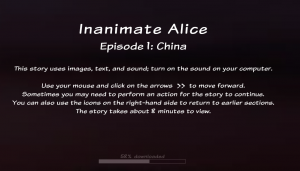Story 2.0
On what new media has to offer to engage us in stories.
Interactivity is the buzz word in the new media realm. But what are we really after when we strive for interactivity? I would argue that the goal is to have the reader/viewer/player/listener engaged. It’s that simple.
Of course, the pinnacle of engagement is in the creative process. I learn much more, for instance, when I teach a class than when I take one. In creating the curriculum, I need to be more invested — mentally and emotionally — in the product of that creation. This sort of logic is, I would argue, behind many of the web 2.0 innovations we’ve seen in recent years. It explains the popularity of sites like YouTube, Facebook, and Flickr. They don’t stop at offering their users content to ingest; they allow the users to create the food they’re eating, too.
But if one of the defining characteristics of web 2.0 is interactivity, does Story 2.0 require the same? As I explained in my last post, I don’t think that the audience of a story can ever co-author it. But I do see the current media environment as doing two important things to engage people in stories. First they (the proverbial they) are giving us some great new tools to create content. And secondly, they are giving us some very engaging delivery systems.
The new media environment has been especially friendly to the visual and audio arts, providing plenty of free services and software that actually help people create more interesting and sophisticated content. A site called aviary has been developing various online software tools to manipulate photos, create vector art, and do other fancy design work. And there are tutorials out there for everything, so even casual Star Wars geeks can make movies with light saber effects.
But when it comes to storytelling, there’s not much in terms of software that you can give people to actually help them craft a better story. I suppose free movie editing programs, bundled with most new computers, have had some impact on how many people are producing movies, but as I’ve learned after 7 or 8 years of teaching video production to high school students, the tools don’t guarantee good stories.
Other people can help you craft better stories, though. And I guess if tutorials are tools, so are internet communities. I can’t say whether the various poetry and fiction forums out there in cyberspace have improved storytelling in general. But they are out there. So in addition to software, add communities to the list of tools.
And then add one more: publication. The arts need an audience. And if the web is good at any one thing, it is good at giving people a stage, however small that stage may be. Blogs, web cams, and image/video hosting sites make it possible for everyone to get published.
Combine the software, a community, and publication, and you have a site like xtranormal. Here’s their “about”:
Xtranormal’s mission is to bring movie-making to the people. Everyone watches movies and we believe everyone can make movies. Movie-making, short and long, online and on-screen, private and public, will be the most important communications process of the 21st century.
Our revolutionary approach to movie-making builds on an almost universally held skill—typing. You type something; we turn it into a movie. On the web and on the desktop.
I decided to give it a try and came up with the following:
So there you have it. Clear evidence that the new media environment offers some new tools for story production. And also clear evidence that the story’s only as good as the storyteller.
But the question isn’t about whether Story 2.0 will be better than previous iterations of narratives. The question is whether our new forms of story are increasing the engagement of the readers.
The tools may or may not help the creators of tales to make more engaging content, but by engaging more people in the creation process, it can’t hurt the consumption end of that cycle.
If story-building tools aren’t helping Story to evolve, though, the various delivery systems offered in the new media environment are certainly adding layers of audience engagement.
The most obvious enhancement brought about by the web is its multi-media nature. Sites are capable of delivering images and sound along with the text we’re reading. Our minds tend to be captivated by information assaults, which is why tv is so good at lulling us into hypnogogic states. But as such mesmerism proves, engagement isn’t always active engagement.
I think Story 2.0 improves upon television by requiring a little more active navigation than is required by the remote control. How? Well, all internet browsers read html and php, and most of them read flash and javascript. These are all coding languages capable of producing dynamic user involvement — to put it simply, they allow for the user to click on things.
I’ve already delved into hypertext fiction, which is the simplest form of “dynamic user involvement.” Even noncritical user involvement (i.e. when the user’s interactivity has no bearing on the direction the story takes — like clicking on next gets you the next page) is still user involvement and is a level higher than television.
And then there’s gameplay, which gives us challenges that exist within a context of a story. Certainly, games are capable of getting us to engage with a narrative quite actively. Even if I maintain that they don’t allow any co-authoring, I must grant that games produce active engagement.
And if we’re talking about games, we’ve got to return to communities. Not only are communities tools in the creation of content, they’re also sometimes part of the delivery system. Book clubs, casual discussion of movies, and academic study — such tried and true community engagement with narratives has always been a part of story delivery. But now we can add group gameplay to that list.
And if we’re really going for gold, we can take a look at “alternate reality games,” which might be the current pinnacle of active audience engagement.
ARGs, as they’re called, begin with a narrative hook that describes some sort of mysterious event. Dana’s Aunt Margaret is having trouble with her website — weird trouble. Or some sort of strange red light has been seen in coastal waters worldwide. Or six amnesiacs wake up, blindfolded, in labyrinths around the world with tattoos on their arms that read, “Trovu la ringon perditan.”
As you investigate these mysteries, you will inevitably stumble upon links to related blogs, email updates, and some sort of forum where you can discuss the details of the mystery with other players/readers. A community of puzzle-solvers forms around the narrative, and more of the plot is revealed as the various players uncover more clues. Typically, the gameplay extends from the virtual world into the real world. So, for instance, the game Perplex City, which began with a magical cube being stolen from some other planet, ends with some real person in England who found the cube in a park in Northhamptonshire.
The vast majority of ARGs are commissioned by some sort of corporation which wants to build hype for a product of theirs. The one that starts with Aunt Margaret having trouble with her website was actually a marketing scheme for the release of Halo 2 and was called “I Love Bees.” The strange red lights in the sea is a current tie-in with the video game Bioshock’s story and is also about building hype for an upcoming Bioshock 2. The six amnesiacs were part of a game called “The Lost Ring,” launched by McDonald’s and the IOC in anticipation of the 2008 Summer Olympics.
More and more television shows are creating ARGs to help expand the universe of the series’ fictional narratives. Dollhouse, The Sarah Connor Chronicles, Heroes, Lost, and a slew of others have all attempted to increase engagement via ARGs. And according to a recent article in the Economist, it’s working.
ARGs may be the best glimpse we can get into what Story 2.0 might end up looking like. They’re marketable, and they lend themselves well to cross-promotion and advertising; as a result, they have some real money behind them, and they get promoted. Most impressively, though, they combine almost everything that the new media environment has to offer: community, interaction, and a multi-media experience.



